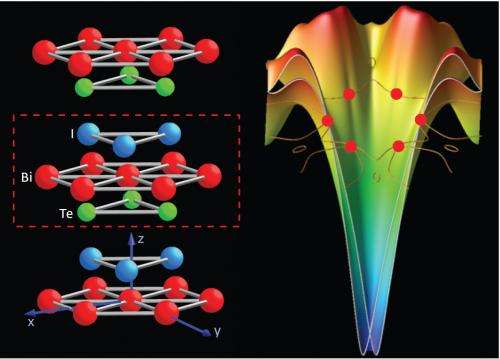One material, two types of magnetism

When placed next to a bar magnet, an aluminum ball draws gently towards the magnet. In contrast, a ball made of silver moves out of the magnetic field. The mechanisms underlying these different behaviors are known as paramagnetism and diamagnetism, respectively. Surprisingly, the material called BiTeI—composed of layers of bismuth, tellurium and iodine atoms—can be either diamagnetic or paramagnetic, depending on how it is prepared.
The finding, by an international research team led by Naoto Nagaosa and Yoshinori Tokura from the RIKEN Advanced Science Institute in Wako, was unexpected because it requires an unusual mechanism to initially make the material magnetic. In BiTeI and related materials, the motion of electrons makes the most important contribution to their magnetism. Electrons move, roughly speaking, on orbital paths around atomic cores. "Orbital motion is usually associated with diamagnetism only," explains Nagaosa. "We were therefore surprised when our calculations [predicted] that there is [also] orbital paramagnetism in BiTeI." The experimental group headed by Tokura confirmed the prediction, as reported in the same paper.
Orbital diamagnetism is observed in a very wide variety of materials, including substances as common as water. Previously, the possibility of orbital paramagnetism, had been considered in only a few theoretical studies. One mechanism that can generate a paramagnetic response of electrons to a magnetic field is known as spin–orbit coupling. This coupling connects the charge of the electron with its spin—the intrinsic angular momentum of the electrons, which is also responsible for their magnetic behavior. In BiTeI, spin–orbit coupling is particularly strong, making it an ideal material for exploring unusual effects of orbital magnetism.
To generate orbital paramagnetism in BiTeI, the trick is to control the number of electrons moving through the crystal. Nagaosa and his colleagues found a specific range where the material is paramagnetic. They showed, however, that there is also a regime when orbital diamagnetism is strongly enhanced, making it possible to fundamentally change the way the material reacts to a magnetic field.
Finding technological applications remains a task for the future, but Nagaosa expects that these unusual behaviors to appear in a broad class of materials. "Other bismuth compounds related to BiTeI should exhibit similar effects, but there might be entirely different solids with orbital paramagnetism," he explains. "Indeed, we have theoretical evidence that the effects we describe will also occur, for example, in various situations in graphene-like materials."
More information: Schober, G.A.H., Murakawa, H., Bahramy, M.S., Arita, R., Kaneko, Y., Tokura, Y. & Nagaosa, N. Mechanisms of enhanced orbital dia- and paramagnetism: application to the Rashba semiconductor BiTeI. Physical Review Letters 108, 247208 (2012). prl.aps.org/abstract/PRL/v108/i24/e247208
Journal information: Physical Review Letters
Provided by RIKEN




















